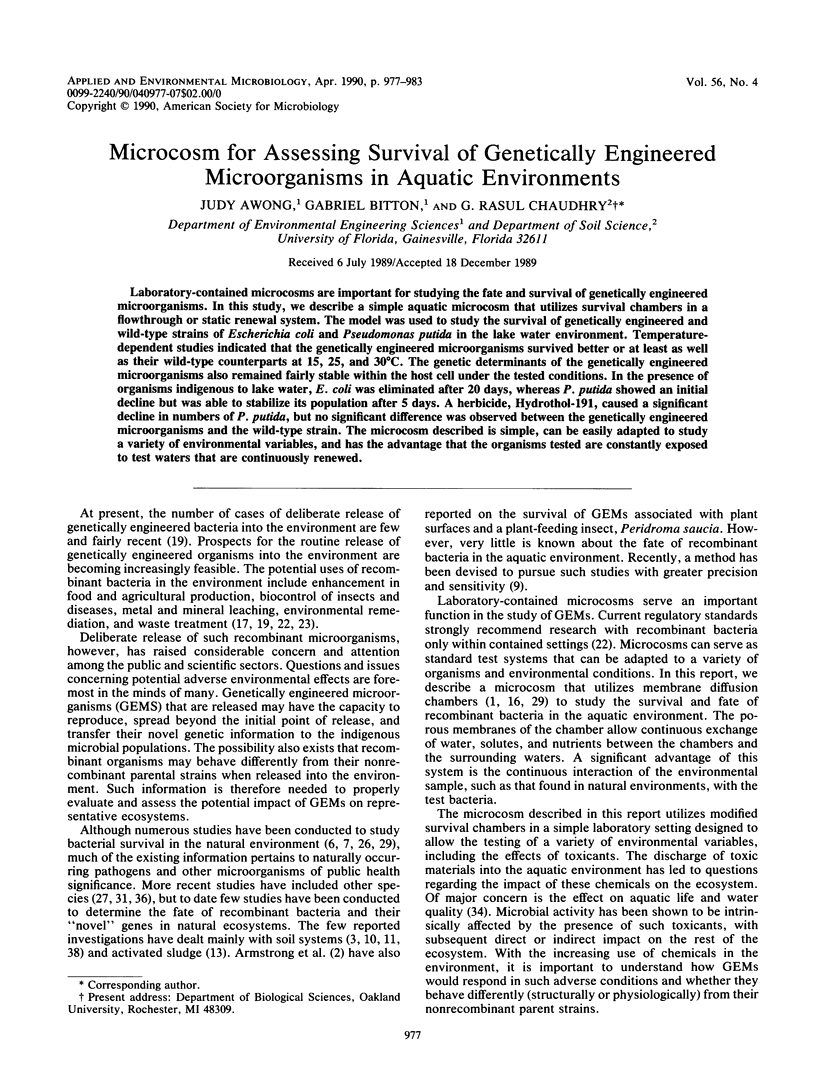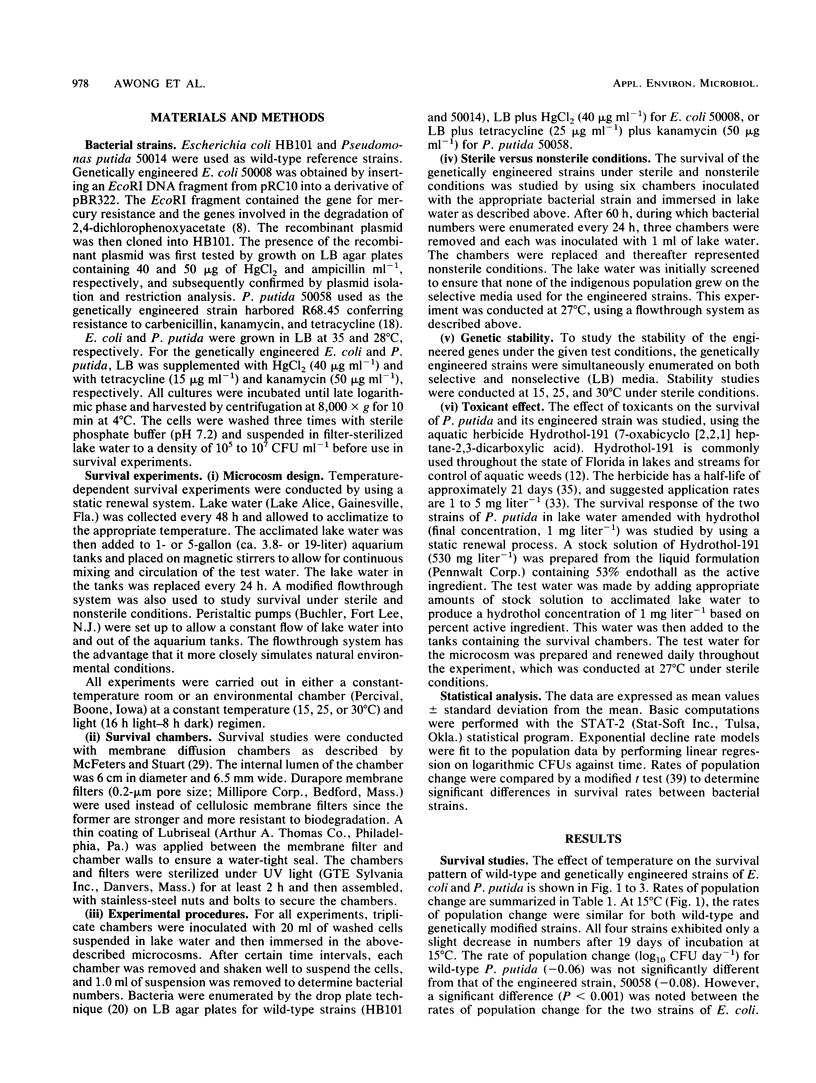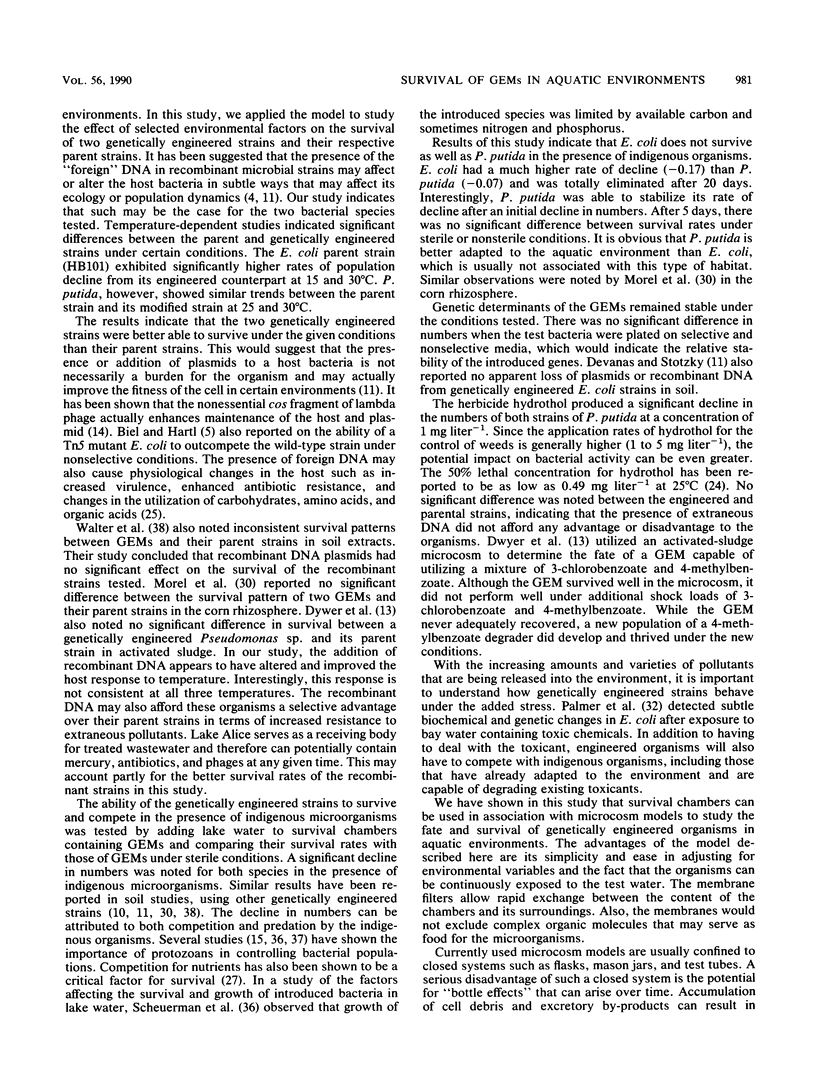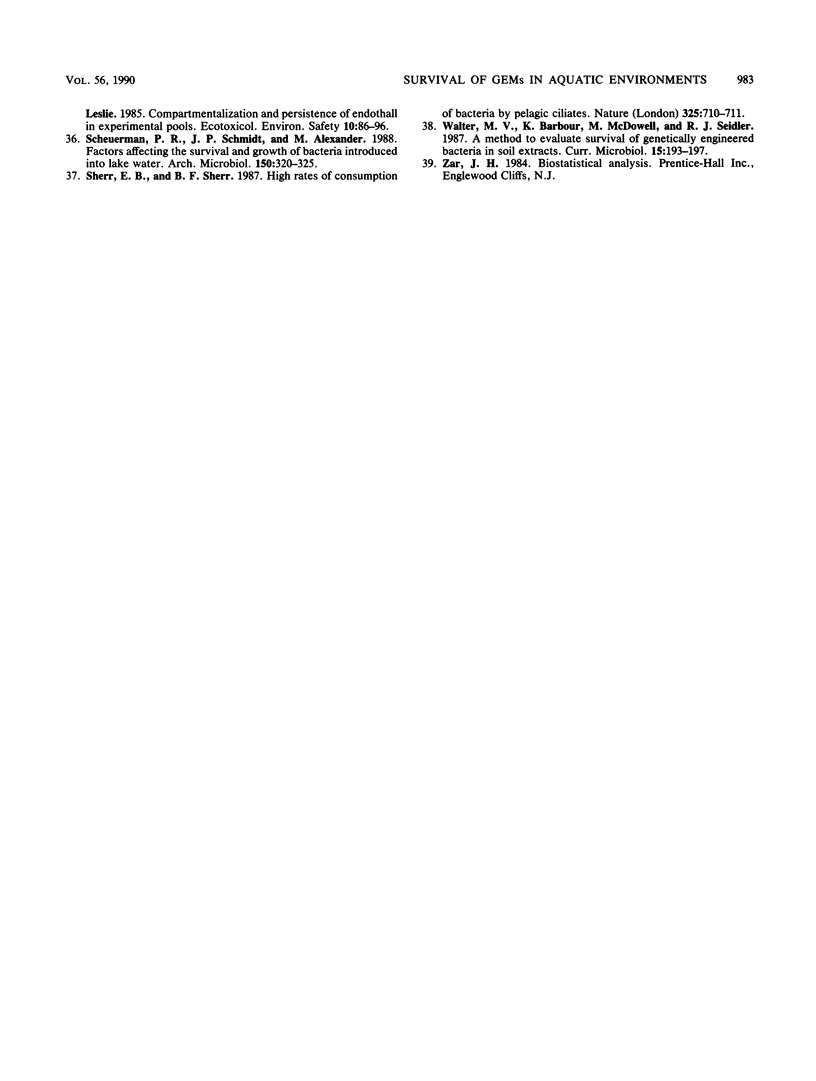Abstract
Laboratory-contained microcosms are important for studying the fate and survival of genetically engineered microorganisms. In this study, we describe a simple aquatic microcosm that utilizes survival chambers in a flowthrough or static renewal system. The model was used to study the survival of genetically engineered and wild-type strains of Escherichia coli and Pseudomonas putida in the lake water environment. Temperature-dependent studies indicated that the genetically engineered microorganisms survived better or at least as well as their wild-type counterparts at 15, 25, and 30 degrees C. The genetic determinants of the genetically engineered microorganisms also remained fairly stable within the host cell under the tested conditions. In the presence of organisms indigenous to lake water, E. coli was eliminated after 20 days, whereas P. putida showed an initial decline but was able to stabilize its population after 5 days. A herbicide, Hydrothol-191, caused a significant decline in numbers of P. putida, but no significant difference was observed between the genetically engineered microorganisms and the wild-type strain. The microcosm described is simple, can be easily adapted to study a variety of environmental variables, and has the advantage that the organisms tested are constantly exposed to test waters that are continuously renewed.
Full text
PDF






Selected References
These references are in PubMed. This may not be the complete list of references from this article.
- Altherr M. R., Kasweck K. L. In situ studies with membrane diffusion chambers of antibiotic resistance transfer in Escherichia coli. Appl Environ Microbiol. 1982 Oct;44(4):838–843. doi: 10.1128/aem.44.4.838-843.1982. [DOI] [PMC free article] [PubMed] [Google Scholar]
- Bentjen S. A., Fredrickson J. K., Van Voris P., Li S. W. Intact soil-core microcosms for evaluating the fate and ecological impact of the release of genetically engineered microorganisms. Appl Environ Microbiol. 1989 Jan;55(1):198–202. doi: 10.1128/aem.55.1.198-202.1989. [DOI] [PMC free article] [PubMed] [Google Scholar]
- Biel S. W., Hartl D. L. Evolution of transposons: natural selection for Tn5 in Escherichia coli K12. Genetics. 1983 Apr;103(4):581–592. doi: 10.1093/genetics/103.4.581. [DOI] [PMC free article] [PubMed] [Google Scholar]
- Bissonnette G. K., Jezeski J. J., McFeters G. A., Stuart D. G. Influence of environmental stress on enumeration of indicator bacteria from natural waters. Appl Microbiol. 1975 Feb;29(2):186–194. doi: 10.1128/am.29.2.186-194.1975. [DOI] [PMC free article] [PubMed] [Google Scholar]
- Burton G. A., Jr, Gunnison D., Lanza G. R. Survival of pathogenic bacteria in various freshwater sediments. Appl Environ Microbiol. 1987 Apr;53(4):633–638. doi: 10.1128/aem.53.4.633-638.1987. [DOI] [PMC free article] [PubMed] [Google Scholar]
- Chaudhry G. R., Huang G. H. Isolation and characterization of a new plasmid from a Flavobacterium sp. which carries the genes for degradation of 2,4-dichlorophenoxyacetate. J Bacteriol. 1988 Sep;170(9):3897–3902. doi: 10.1128/jb.170.9.3897-3902.1988. [DOI] [PMC free article] [PubMed] [Google Scholar]
- Chaudhry G. R., Toranzos G. A., Bhatti A. R. Novel method for monitoring genetically engineered microorganisms in the environment. Appl Environ Microbiol. 1989 May;55(5):1301–1304. doi: 10.1128/aem.55.5.1301-1304.1989. [DOI] [PMC free article] [PubMed] [Google Scholar]
- Fliermans C. B., Gorden R. W. Modification of membrane diffusion chambers for deep-water studies. Appl Environ Microbiol. 1977 Jan;33(1):207–210. doi: 10.1128/aem.33.1.207-210.1977. [DOI] [PMC free article] [PubMed] [Google Scholar]
- Haas D., Holloway B. W. R factor variants with enhanced sex factor activity in Pseudomonas aeruginosa. Mol Gen Genet. 1976 Mar 30;144(3):243–251. doi: 10.1007/BF00341722. [DOI] [PubMed] [Google Scholar]
- Hoben H. J., Somasegaran P. Comparison of the Pour, Spread, and Drop Plate Methods for Enumeration of Rhizobium spp. in Inoculants Made from Presterilized Peat. Appl Environ Microbiol. 1982 Nov;44(5):1246–1247. doi: 10.1128/aem.44.5.1246-1247.1982. [DOI] [PMC free article] [PubMed] [Google Scholar]
- Holmberg D. J., Lee G. F. Effects and persistence of endothall in the aquatic environment. J Water Pollut Control Fed. 1976 Dec;48(12):2738–2746. [PubMed] [Google Scholar]
- Keeler K. H. Can we guarantee the safety of genetically engineered organisms in the environment? Crit Rev Biotechnol. 1988;8(1):85–97. doi: 10.3109/07388558809150538. [DOI] [PubMed] [Google Scholar]
- Keller A. E., Dutton R. J., Bitton G., Crisman T. L. Chronic toxicity of Hydrothol-191 to Ceriodaphnia dubia at 25 and 15 degrees C. Bull Environ Contam Toxicol. 1988 Aug;41(2):233–240. doi: 10.1007/BF01705436. [DOI] [PubMed] [Google Scholar]
- Kozyrovskaya N. A., Gvozdyak R. I., Muras V. A., Kordyum V. A. Changes in properties of phytopathogenic bacteria effected by plasmid pRD1. Arch Microbiol. 1984 Apr;137(4):338–343. doi: 10.1007/BF00410731. [DOI] [PubMed] [Google Scholar]
- Lessard E. J., Sieburth J. M. Survival of natural sewage populations of enteric bacteria in diffusion and batch chambers in the marine environment. Appl Environ Microbiol. 1983 Mar;45(3):950–959. doi: 10.1128/aem.45.3.950-959.1983. [DOI] [PMC free article] [PubMed] [Google Scholar]
- Liang L. N., Sinclair J. L., Mallory L. M., Alexander M. Fate in model ecosystems of microbial species of potential use in genetic engineering. Appl Environ Microbiol. 1982 Sep;44(3):708–714. doi: 10.1128/aem.44.3.708-714.1982. [DOI] [PMC free article] [PubMed] [Google Scholar]
- McFeters G. A., Bissonnette G. K., Jezeski J. J., Thomson C. A., Stuart D. G. Comparative survival of indicator bacteria and enteric pathogens in well water. Appl Microbiol. 1974 May;27(5):823–829. doi: 10.1128/am.27.5.823-829.1974. [DOI] [PMC free article] [PubMed] [Google Scholar]
- McFeters G. A., Stuart D. G. Survival of coliform bacteria in natural waters: field and laboratory studies with membrane-filter chambers. Appl Microbiol. 1972 Nov;24(5):805–811. doi: 10.1128/am.24.5.805-811.1972. [DOI] [PMC free article] [PubMed] [Google Scholar]
- Ohana B., Margalit J., Barak Z. Fate of Bacillus thuringiensis subsp. israelensis under Simulated Field Conditions. Appl Environ Microbiol. 1987 Apr;53(4):828–831. doi: 10.1128/aem.53.4.828-831.1987. [DOI] [PMC free article] [PubMed] [Google Scholar]
- Reinert K. H., Rodgers J. H., Jr, Hinman M. L., Leslie T. J. Compartmentalization and persistence of endothall in experimental pools. Ecotoxicol Environ Saf. 1985 Aug;10(1):86–96. doi: 10.1016/0147-6513(85)90010-7. [DOI] [PubMed] [Google Scholar]
- Scheuerman P. R., Schmidt J. P., Alexander M. Factors affecting the survival and growth of bacteria introduced into lake water. Arch Microbiol. 1988;150(4):320–325. doi: 10.1007/BF00408301. [DOI] [PubMed] [Google Scholar]


